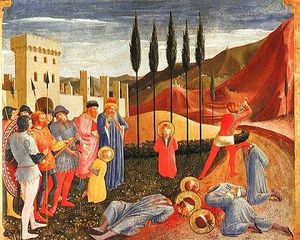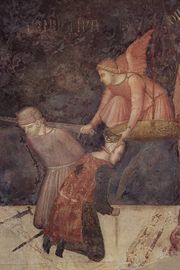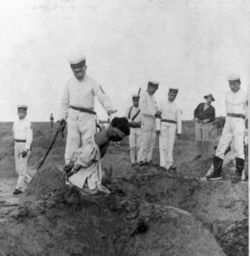Decapitation
| Part of a series on |
| Capital punishment |
|---|
| Issues |
| Debate · Religion and capital punishment · Wrongful execution |
| Current use |
| Belarus · PR China · Ecuador · Egypt · India · Iran · Iraq · Israel · Japan · Malaysia · Mongolia · North Korea · Pakistan · Russia · Saudi Arabia · Singapore · South Korea · Taiwan (ROC) · Tonga · United States |
| Past use |
| Australia · Brazil · Bulgaria · Canada · Denmark · France · Germany · Italy · Mexico · Netherlands · New Zealand · Philippines · Poland · Portugal · Romania · San Marino · Turkey · United Kingdom · Venezuela |
| Current methods |
| Decapitation · Electrocution · Firing squad · Gas chamber · Hanging · Lethal injection · Shooting · Stoning · Nitrogen asphyxiation (proposed) |
| Past methods |
| Boiling · Breaking wheel · Burning · Crucifixion · Crushing · Disembowelment · Dismemberment · Execution by elephant · Flaying · Impaling · Necklacing · Sawing · Slow slicing · Torture |
| Other related topics |
| Crime · Death row · Last meal · Penology |



Decapitation (from Latin, caput, capita, meaning head) is the separation of the head from the body. Beheading typically refers to the act of intentional decapitation, e.g., as a means of murder or execution; it may be accomplished, for example, with an axe, sword, knife, wire, or by means of a guillotine. Ritualistic decapitation after execution by some other means, sometimes followed by public display of the severed head, has also been common throughout history. An executioner carrying out decapitations is called a headsman.
Accidental decapitation can be the result of an explosion, car or industrial accident,[1] improperly administered execution by hanging or other violent injury. Suicide by decapitation is rare, but not unknown.[2]
Decapitation is quickly and invariably fatal, as brain death occurs within minutes without circulating oxygenated blood. Functional reattachment of a severed head (which would require repair of the spinal cord, blood vessels, muscles, and other critically important tissues) is not possible through any known medical technology.
The word decapitation can also refer, on occasion, to the removal of the head from a body that is already dead. This might be done to take the head as a trophy, for public display, to make the deceased more difficult to identify, for cryonics or for other reasons.
In an analogous fashion, decapitation can also refer to the removal of a head of an organization. If, for example, the leader of a country were killed, that might be referred to as 'decapitation'. It is also used of a political strategy aimed at unseating high-profile members of a party, as used by the Liberal Democrats in the United Kingdom general election, 2005.[3]
Contents |
History


Honour
Decapitation has been used as a form of capital punishment for millennia. The terms "capital offence", "capital crime", "capital punishment," derive from the Latin caput, "head", referring to the punishment for serious offenses involving the forfeiture of the head; i.e. death by beheading[4]. Decapitation by sword (or axe, a military weapon as well) was sometimes considered the "honorable" way to die for an aristocrat, who, presumably being a warrior, could often expect to die by the sword in any event; in England it was considered a privilege of noblemen to be beheaded. This would be distinguished from a "dishonorable" death on the gallows or through burning at the stake. In medieval England, high treason by nobles was punished by beheading; male commoner traitors, including knights, were hanged, drawn, and quartered; female commoner traitors were burned at the stake. Paul of Tarsus was beheaded as a Roman citizen, not crucified like other Christians who were Roman slaves or Jews.
In countries where beheading was the usual means of capital punishment, such as in Scandinavia, the noblemen would be beheaded with a sword, symbolizing their class as a military caste, thus dying by an instrument of war, while the commoners would be beheaded with an axe.
Painlessness
If the headsman's axe or sword was sharp and his aim was true, decapitation was quick and was presumed to be a relatively painless form of death. If the instrument was blunt or the executioner clumsy, however, multiple strokes might be required to sever the head. The person to be executed was therefore advised to give a gold coin to the headsman to ensure that he did his job with care. Robert Devereux, 2nd Earl of Essex, and Mary, Queen of Scots, required three strikes at their respective executions. Margaret Pole, 8th Countess of Salisbury, required ten strokes before the fatal blow.

To ensure that the blow would be fatal, executioners' swords usually were blade-heavy two-handed swords. Likewise, if an axe was used, it almost invariably would be wielded with both hands. In England a special form of axe was used for beheadings, with the blade's edge extending downwards from the tip of the shaft.
Finland's official beheading axe resides today at the Museum of Crime in Helsinki. It is a broad-bladed two-handed axe. It was last used when murderer Tahvo Putkonen was executed in 1825. All subsequent Finnish executions were made by firing squad. Capital punishment is no longer practiced in Finland.
Guillotine
Decapitation by guillotine was a common, mechanically assisted form of execution, invented shortly before the French Revolution (although an earlier version of the guillotine, the Halifax Gibbet, was used in Halifax, England from 1286 until the 17th century). The aim was to create a painless and quick form of execution that did not require great skill to carry out. The executioner, after chopping off the head, would hold it up to the crowd. There is some evidence that the head could remained conscious for up to ten seconds [5]. The account of Dr. Beaurieux who observed the decapitation of a convict named Languille in 1905, may imply that the head could still see as he recounts "Next Languille's eyes very definitely fixed themselves on mine and the pupils focussed themselves" (A history of the guillotine, Alister Kershaw). The French had a strict code of etiquette surrounding the executions; a man named Legros, one of the assistants at the execution of Charlotte Corday, was imprisoned for three months and dismissed for slapping the face of the victim after the blade had fallen in order to see whether any flicker of life remained . The guillotine was used in France during the French Revolution and remained the normal judicial method in both peacetime and wartime into the 1970s, although the firing squad was used in certain cases. France abolished the death penalty in 1981. The guillotine was also used in Algeria before the French relinquished control of it, as shown in Gillo Pontecorvo's film The Battle of Algiers. Another guillotine existed in Vatican City until recent years. It had been brought in by Napoleon's forces during the early 19th century; and, in 1870, the Pope still claimed the authority to use it. In recent times however, the Vatican has abolished capital punishment in its own jurisdiction, and recent Popes have condemned capital punishment where it is still practiced.

German Fallbeil
Many German states had used a guillotine-like device known as a Fallbeil since the 17th and 18th centuries, and decapitation by guillotine was the usual means of execution in Germany until the abolition of the death penalty in West Germany in 1949. In Nazi Germany, the guillotine was reserved for criminal convicts and political crimes including treason. A famous example of the guillotine being used was on the members of the White Rose resistance movement, a group of students in Munich led by Sophie Scholl and her brother Hans. Contrary to popular myth, executions were generally not conducted face-up, and chief executioner Johann Reichhart was peculiarly insistent on maintaining "professional" protocol throughout the era, having administered the death penalty during the earlier Weimar era. Nonetheless, the Nazis' use of the Fallbeil was chillingly routine. It is estimated that some 16,500 persons were guillotined in Germany and Austria between 1933 and 1945. This number includes resistance fighters both in Nazi Germany itself and in those countries that were occupied by them. As these resistance fighters were not part of any regular army they were considered common criminals and were in many cases taken to Germany and decapitated. Decapitation was considered a "dishonorable" death, unlike an "honorable" death, e.g., execution by firing squad.

Propaganda
In the days before photography, it was sometimes important to maintain some visual evidence for identification of executed criminals for public display as a form of political propaganda or intimidation. Public display of the severed head of a well-known person could serve this purpose.
Historical practices by nation
Asia
China

In traditional China decapitation was considered a more severe form of punishment than strangulation although strangulation caused more prolonged suffering. This was because in Confucian tradition bodies were gifts from their parents, and so it was therefore disrespectful to their ancestors to return their bodies to the grave dismembered. The Chinese however had other punishments, such as dismembering the body into multiple pieces (similar to English quartering). In addition, there was also a practice of cutting the body at the waist, which was a common way of execution before being abolished in early Qing dynasty and the lingering death. In some tales, people did not die immediately without head.[6][7][8][9]
Pakistan
Pakistan's government employs death by hanging for capital punishment. Since 2007, militants from Tehrek-e-Taliban Pakistan have used beheadings as a form of punishment for opponents, criminals and spies in the north west region of Pakistan. Severed heads of opponents or government officials in Swat were left on popular street corners in order to terrorize local population. The beheadings have stopped in Swat since the military incursion and sweep-up that began in May 2009 and ended in June 2009. Three Sikhs were beheaded by the Taliban in Pakistan in 2010.
A video obtained by the Associated Press on April 20, 2007 shows a young boy, appearing to be around 12 years of age, beheading a man identified as Ghulam Nabi, a Pakistani militant accused of betraying the Taliban. According to the AP report, "A continuous 2½-minute shot then shows the victim lying on his side on a patch of rubble-strewn ground. A man holds Nabi by his beard while the boy, wearing a camouflage military jacket and oversized white sneakers, cuts into the throat. Other men and boys call out "Allahu akbar!" — "God is great!" — during the beheading. The film, overlain with nasheeds, then shows the boy hacking and slashing at the man's neck until the head is severed."[10]
Japan

In Japan, decapitation was a common punishment, sometimes for minor offenses. Samurai were often allowed to decapitate soldiers who had fled from battle, as it was considered cowardly. Decapitation was historically performed as the second step in seppuku (ritual suicide by disembowelment). After the victim had sliced his own abdomen open, another warrior would strike his head off from behind with a katana to hasten death and to reduce the suffering. The blow was expected to be precise enough to leave intact a small strip of skin at the front of the neck—to spare invited and honored guests the indelicacy of witnessing a severed head rolling about, or towards them; such an event would have been considered inelegant and in bad taste. The sword was expected to be used upon the slightest sign that the practitioner might yield to pain and cry out—avoiding dishonor to him and to all partaking in the privilege of observing an honorable demise. As skill was involved, only the most trusted warrior was honored enough to take part. In the late Sengoku period, decapitation was performed as soon as the person chosen to carry out seppuku had made the slightest wound to his abdomen.
Decapitation (without seppuku) was also considered very severe and degrading form of punishment. One of the most brutal decapitations was that of Sugitani Jenjubo (ja:杉谷善住坊), who attempted to assassinate Oda Nobunaga, a prominent daimyo in 1570. After being caught, Jenjubo was buried alive in the ground with only his head out, and the head was slowly sawn off with a bamboo saw by passers-by for several days (Punishment of sawing; nokogiribiki; ja:鋸挽き).[11] These unusual punishments were abolished in the early Meiji era. However, the Japanese used decapitation extensively during World War II, especially against Chinese Nationals. After World War II, Japan stopped using decapitation as a punishment against both Japanese citizens and foreign citizens.

Korea
Historically, decaptitation had been the most common method of execution in Korea, until it was replaced by hanging in 1896. Professional executioners were called "Mangnani" (망나니) and belonged to the lowest class of people.[12]
Thailand
In Southern Thailand, there were at least 15 cases where Buddhists have been beheaded in 2005. Thai officials suspect the attackers are part of the South Thailand Muslim insurgency who are seeking to separate the south end part from the rest of Thailand.[13][14]
Europe
Classical Antiquity
In the Roman Republic of the early 1st century BC, it became the tradition for the severed heads of public enemies — such as the opponents of Marius and Sulla for example — to be publicly displayed on the Rostra in the Forum Romanum after execution. Perhaps the most famous such victim was Cicero who, on instructions from Marc Antony, had his hands (which had penned the Philippics against Antony) and his head cut off and nailed up for display in this manner.
Bosnia and Herzegovina
During the war in Bosnia and Herzegovina (1992–1995) there were a number of ritual beheadings of Serbs who were taken as prisoners of war by mujahedin members of the Bosnian Army. At least one case is documented and proven in court by the ICTY where mujahedin, members of 3rd Corps of Army BiH, beheaded Bosnian Serb Dragan Popović.[15][16] Another case of beheadings of Serbs is documented to have happened on Kazani, on Trebevic mountain above Sarajevo. Mostly Serb civilians were killed by beheading, and later on thrown in the Kazani pit. These actions were performed by several soldiers of the 10th mountain brigade under the command of Musan Topalovic - Caco.[17]
Frisia
During the Frisian Peasant Rebellion between 1515 and 1523, the Burgundian and Habsburgian enemies were usually beheaded when captured to prevent them from returning to fight again. The rebel leader, Pier Gerlofs Donia performed many of the decapitations. He was known for his amazing skill and for the ability to behead multiple people in a single blow using a Zweihänder with the amazing length of 213 cm (~7 ft). For his extreme brutality he was nicknamed "Cross of the Dutchmen".[18]
Kosovo
A Serbian newspaper, Večernje Novosti, published photos in 2003 of men in Kosovo Liberation Army uniforms holding decapitated heads. According to the paper, the Albanian terrorists commited the crime in April 1999, during the Kosovo War.[19][20]
Germany
- In July 1931, notorious serial killer Peter Kürten, known as "The Vampire of Düsseldorf", was executed on the guillotine in Cologne.
- On 1 August 1933, in Altona, Bruno Tesch and three others were beheaded. These were the first executions in the Third Reich. The executions concerned the Altona Bloody Sunday (Altonaer Blutsonntag) riot, an SA march on 17 July 1932 that turned violent and led to 18 people being shot dead [21][22].
- Marinus van der Lubbe in 1934 after a show trial in which he was found guilty of starting the Reichstag fire.
- In February 1935 Benita von Falkenhayn and Renate von Natzmer were beheaded with the axe and block in Berlin for espionage for Poland. Axe beheading was the only method of executions in Berlin until 1938.
- In February 1943, university students Hans Scholl, his sister Sophie Scholl, and Christoph Probst of the White Rose protest movement, for distributing anti-war and anti-Nazi leaflets. Four other members of the White Rose were also executed by the Nazi People's Court later that same year. The anti-Nazi Helmuth Hübener was also decapitated by People’s Court order.
Nordic countries
In Nordic Countries, decapitation was the usual means of carrying out capital punishment. Noblemen were beheaded with a sword, and commoners with an axe. The last executions by decapitation in Finland in 1825, Norway in 1876 and in Iceland in 1830 were carried out with axes. The same was the case in Denmark in 1892. The last decapitation in Sweden was carried out in 1910 with a guillotine. The last execution in Sweden carried out with an axe was in 1900.
The official beheading axe of Finland resides today in the Museum of Crime, Helsinki.
Spain
In Spain executions were carried out by various methods including strangulation by the garrotte. In the 16th and 17th centuries, noblemen were sometimes executed by means of beheading. They were tied to a chair on a scaffold. The executioner used a knife to cut the head from the body. It was considered to be a more honourable death if the executioner started with cutting the throat[23].
North America
Mexico
Miguel Hidalgo y Costilla, Ignacio Allende, José Mariano Jiménez and Juan Aldama were tried for treason, executed by firing squad and beheaded during the Mexican independence in 1811. Their heads were on display on the four corners of the Alhóndiga de Granaditas, in Guanajuato.
Recently during the Mexican Drug War some Mexican drug cartels have turned to decapitation of rival cartel members as a method of intimidation.[24]
United States
In 1851, the state of Utah introduced beheading as an optional method of execution. No prisoner chose this method and it fell out of practice in 1888.
Middle East
Saudi Arabia
Saudi Arabian authorities beheaded four men in February 2007— Sangeeth Kumara, Victor Corea, Ranjith Silva and Sanath Pushpakumara. These four Sri Lankan workers were convicted in a Saudi Arabian court for an armed robbery committed in October 2004. Their deaths sparked reactions from the international human rights watchdog Amnesty International, which called on the Saudi authorities to abolish the death sentence. The court also ruled that the bodies of the four workers be crucified for public view as an example for others. In most of the cases the respective embassy gets notification only after the execution thereby eliminating chances for international or diplomatic uproar.[25]
Iraq
Beheadings have emerged as another terror tactic especially in Iraq since 2003.[26] Civilians have borne the brunt of the beheadings, although U.S. and Iraqi military personnel have also been targeted. After kidnapping the victim, the kidnappers typically make some sort of demand of the government of the hostage's nation and give a time limit for the demand to be carried out, often 72 hours. Beheading is often threatened if the government fails to heed the wishes of the hostage takers. Frequently the crude beheadings are videotaped and made available on the Internet. One of the most publicized of such executions was that of Olin Eugene Armstrong.
The type of "beheading" practiced by Al Qaeda and similar groups differs from traditional judicial beheading. Traditional beheading is done quickly, with a massive steel blade, which cuts through the neck from the back, first severing the spinal column, then cutting the four large blood vessels, the trachea, and the esophagus. Unconsciousness is nearly instantaneous, and brain death occurs shortly thereafter. Terrorist-style beheading is reversed: using a rather small knife, first the killer cuts the throat, severing the carotid arteries and jugular veins, the trachea, and the esophagus, causing the victim to bleed out within a minute; then the spine is slowly severed by an instrument that is not really massive enough for the job (acceptable substitutes would include a machete, a butcher's cleaver, or a more traditional sword or axe). The first half of this procedure follows the method for Islamic ritual slaughter of food animals. The second half follows no clear precedent.
Judicial execution is practiced in Iraq, but is generally carried out by hanging.
Africa
Somalia
On March 13, 2008, it was reported that Hizbul Shabaab militants fighting the presence of an interim government backed by thousands of Ethiopian combat troops in Somalia beheaded three government soldiers. It was the first case of beheadings since the government and its Ethiopian military allies ousted the Islamists from power in late 2006, sparking a bloody insurgency characterised by roadside bombs and hit-and-run attacks.[27]
Notable people who have been beheaded
See also
- Blood squirt, a result from a decapitation
- Cephalophore
- Chinnamasta, a Hindu goddess who decapitates herself and holds her head in her hand
- Dismemberment
- Headhunting
- Head transplant
- Dr. Sergey Bryukhonenko who kept decapitated dog heads alive for some time by perfusing them with oxygenated blood.
- Dr. Vladimir Demikhov who preformed head transplantation on dogs
- Dr. Robert J. White who preformed head transplantation on monkeys
- Experiments in the Revival of Organisms a 1940 film featuring one of Bryukhonenko's decapitated dog heads
- Internal decapitation, where the skull is dislodged from the spine; a typically, but not always, fatal injury
- List of methods of capital punishment
- Mike the Headless Chicken
- Paul Loye - studied movement of various parts of the body after decapitation
- Silent Woman
- Sword of Justice
References
- ↑ see Isadora Duncan
- ↑ "Guillotine death was suicide". BBC News. 2003-04-24. http://news.bbc.co.uk/1/hi/england/tyne/2974083.stm. Retrieved 2008-09-26.
- ↑ Carlin, Brendan; David Sapsted (2005-05-04). "Defiant Kennedy takes 'decapitation' strategy into Tory heartland". The Telegraph (London). http://www.telegraph.co.uk/news/uknews/1489270/Defiant-Kennedy-takes-'decapitation'-strategy-into-Tory-heartland.html. Retrieved 2008-06-21.
- ↑ Webster's Revised Unabridged Dictionary, edited by Noah Porter, published by G & C. Merriam Co., 1913
- ↑ www.damninteresting.com/lucid-decapitation Article on post-decapitation consciousness
- ↑ 原來斬頭係唔會即刻死既(仲識講野)中國有好多斬頭案例!!
- ↑ “无头人”挑战传统医学 人类还有个“腹脑”?
- ↑ 福州晚報
- ↑ 换人头
- ↑ The Star Online Video in Pakistan shows youngster beheading man for alleged betrayal of Taliban leader Dated: Saturday, April 21, 2007.
- ↑ [1] Asahi Dictionary of Japanese Historical Figures
- ↑ Doosan Encyclopedia
- ↑ "Buddhist decapitated in Thailand". Herald Sun. 2005-07-26. http://www.news.com.au/heraldsun/story/0,21985,16055672-1702,00.html. Retrieved 2008-02-15.
- ↑ "Man beheaded, two shot dead the man was later found in a shallow grave.". News Limited. 2005-10-14. http://www.news.com.au/story/0,10117,16917051-23109,00.html. Retrieved 2008-02-15.
- ↑ UN - TRIBUNAL CONVICTS ENVER HADZIHASANOVIC AND AMIR KUBURA Press Release, March 2006
- ↑ UN - THIRD AMENDED INDICTMENT - THE INTERNATIONAL CRIMINAL TRIBUNAL FOR THE FORMER YUGOSLAVIA
- ↑ - 100 SVJEDOKA PROTIV 10. BRDSKE
- ↑ "Greate Pier fan Wûnseradiel" (in West Frisian). Gemeente Wûnseradiel. http://www.wunseradiel.nl/index.php?simaction=content&pagid=289&mediumid=1. Retrieved 2008-01-04.
- ↑ http://www.kosovo.net/kla_decapit.jpg
- ↑ http://www.ex-yupress.com/evnovosti/evnovosti13.html
- ↑ asfpg ~ Altonaer Stiftung für philosophische Grundlagenforschung
- ↑ "Movies: About Das Beil Von Wandsbek". The New York Times. http://movies.nytimes.com/movie/157552/The-Axe-of-Wandsbek/overview.
- ↑ Execution of the Marquess of Ayamonte on the 11th. of december 1645 Described in "Varios relatos diversos de Cartas de Jesuitas" (1634–1648) Coll. Austral Buones Aires 1953 en Dr. J. Geers "Van het Barokke leven", Baarn 1957 Bl. 183 - 188.
- ↑ George W. Grayson (February 2009). "La Familia: Another Deadly Mexican Syndicate". Foreign Policy Research Institute. Archived from the original on 2009-09-15. http://www.webcitation.org/5joR97DuX.
- ↑ BBC
- ↑ "The Terrorist as Auteur"
- ↑ Garowe Online - Home
![]() This article incorporates content from the 1728 Cyclopaedia, a publication in the public domain.
This article incorporates content from the 1728 Cyclopaedia, a publication in the public domain.